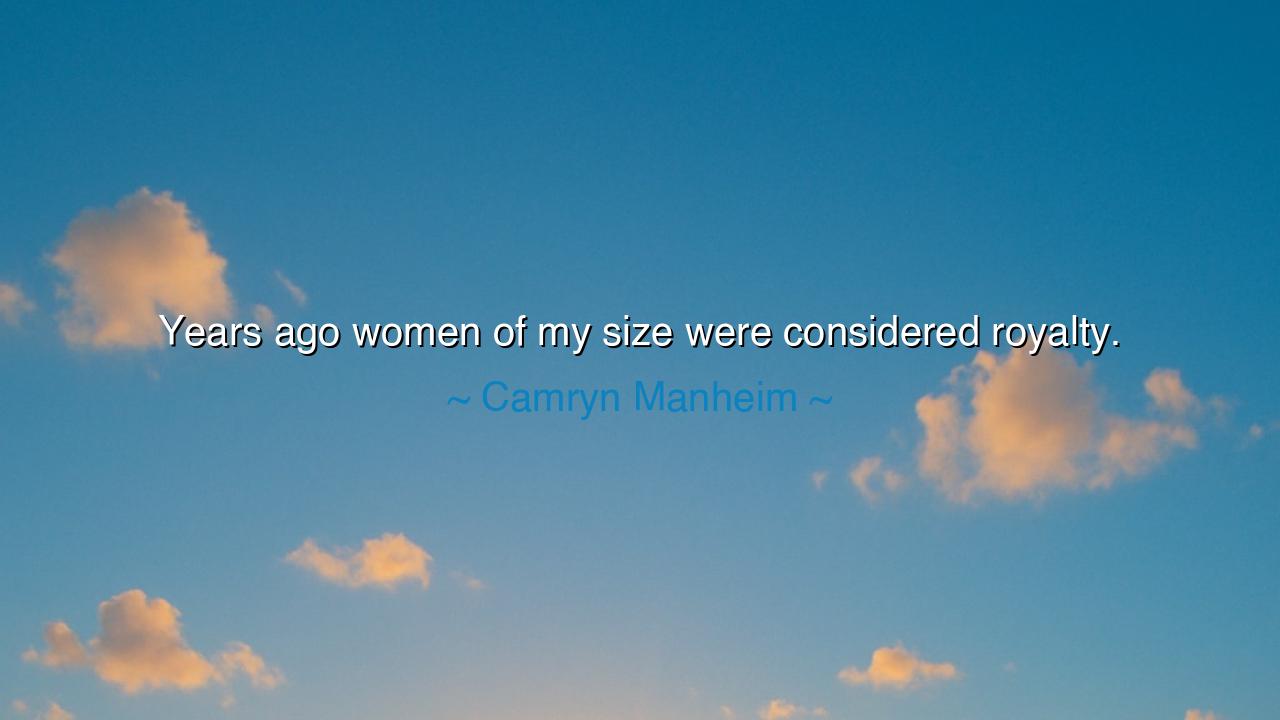
Years ago women of my size were considered royalty.






Hear the proud and piercing words of Camryn Manheim: “Years ago women of my size were considered royalty.” With these words, she does more than speak of her own body—she speaks of history, of shifting standards, of how beauty and worth are shaped not by truth but by culture. In her declaration is a cry of defiance against a narrow world that too often chains women to fleeting ideals. She reminds us that the very body once adorned with crowns has, in another age, been cast aside by prejudice. Thus, her words are both a challenge and a remembrance.
The origin of this saying lies in the tides of cultural history. In many past civilizations, a fuller body was revered as a symbol of abundance, fertility, and wealth. To be well-fed was to be secure, to carry on the promise of life in times when famine stalked the poor. In the Renaissance, in Baroque art, the women painted by masters such as Rubens bore the fullness of flesh, and this was seen as divine, sensual, and noble. Manheim, an actress who rose to prominence in an industry that often idolizes thinness, reclaims this forgotten truth, saying that her size is not a flaw but a crown, once a mark of royalty.
History itself confirms her words. Consider the queens of ancient Egypt, whose depictions show them strong, rounded, and commanding. Or look to Polynesian cultures, where a fuller form symbolized status and health, and the slim body was considered a sign of weakness. Even in Europe, the nobility’s bodies were rounder because they alone had constant access to rich foods. Thus, what today’s culture scorns, another era exalted. The standard of beauty was not fixed but shaped by time and circumstance.
The deeper meaning of Manheim’s declaration is that value must never be chained to fashion. Society’s ideals shift like the wind—today praising thinness, tomorrow praising curves, always changing, never stable. But true worth, true majesty, lies in character, spirit, and the ability to live authentically. By claiming that her size was once a mark of royalty, Manheim does not simply dwell on the past; she urges us to see beyond the narrow definitions of the present, to remember that dignity belongs to all forms.
The lesson is clear: never allow society to dictate your value. What is scorned in one age may be exalted in another. True confidence arises not from bending to the demands of fleeting standards, but from embracing the fullness of who you are. Beauty is not a garment worn for the moment; it is an eternal flame, carried within, that shines regardless of the body that bears it.
To the youth, I say: let not the mirror of society distort your vision of yourself. To women, I say: remember the queens of old, whose crowns were heavy not only with jewels but with pride in their own form. To men, I say: honor the diversity of beauty, and know that worth cannot be measured in inches or pounds.
Practical action lies before us: reclaim self-worth from the grasp of shifting ideals. Teach children the history of beauty in all its forms, so they may grow free of chains. Surround yourself with voices that uplift rather than diminish. And when you look in the mirror, remember that you are the descendant of queens and kings, and that dignity flows in your blood regardless of shape.
Thus Camryn Manheim’s words endure: “Years ago women of my size were considered royalty.” They remind us that the world’s gaze is fickle, but truth is steady. Let us then walk proudly, not as slaves to fleeting ideals, but as heirs of dignity eternal—bearing ourselves as though crowned, for in truth, we are.






NNNguyen Nhu
I think this quote speaks to the idea that beauty is subjective and often dictated by the times. The shift in how body size is perceived over the years shows how culture and media shape these standards. Why do you think certain body types were once considered royalty and are now considered less desirable? Is this something that can change again, or are we stuck in a cycle?
CCCute Cuong
This quote makes me reflect on how women’s worth has often been tied to physical appearance, and how that definition has evolved—or hasn’t. It’s curious how certain body types, once considered desirable, are now marginalized. What would it take to bring back a more inclusive understanding of beauty, where all body types are appreciated for what they represent beyond aesthetics?
VD09. Hoang Van Dat
I love how Camryn Manheim brings attention to this historical perspective. It’s interesting that once upon a time, fuller figures were a symbol of wealth and power, while now there seems to be an obsession with being slim. What can we learn from the past to challenge today's beauty ideals? Could embracing this historical perspective help change the way society views body size today?
NKnguyẽn nguyen khang
This quote really resonates with me because it highlights the cyclical nature of beauty standards. It's crazy how the way society views body size changes over time. What does it say about how we value people based on their appearance? Shouldn’t we be moving toward embracing diversity in all its forms, rather than constantly reshaping the ideal body type?
ISIsagi Shiina
I find this quote both thought-provoking and bittersweet. It makes me think about how beauty standards have shifted over time. Why is it that in some eras, larger women were celebrated, but today, there’s often a narrow definition of what is considered beautiful? Can we reclaim these past ideals and appreciate different body types again, or have beauty standards become too ingrained?